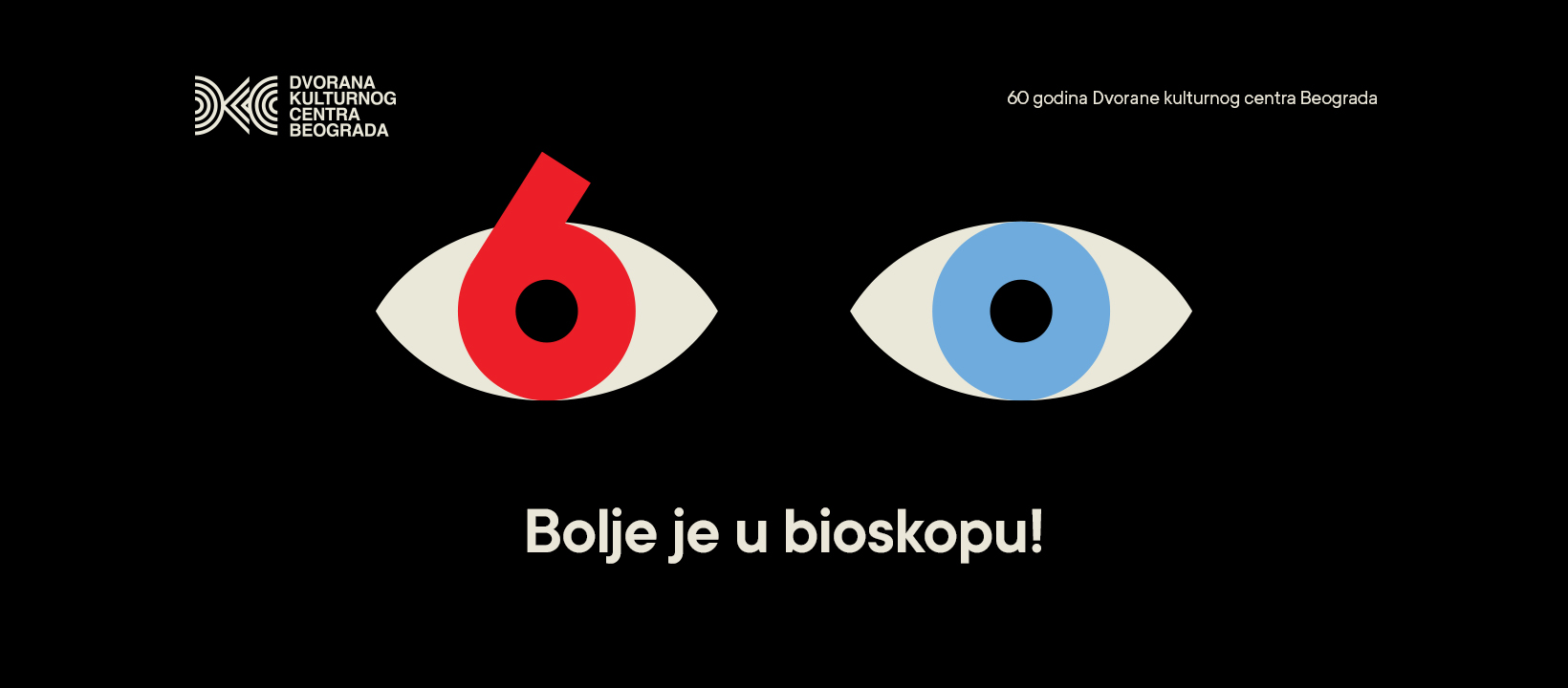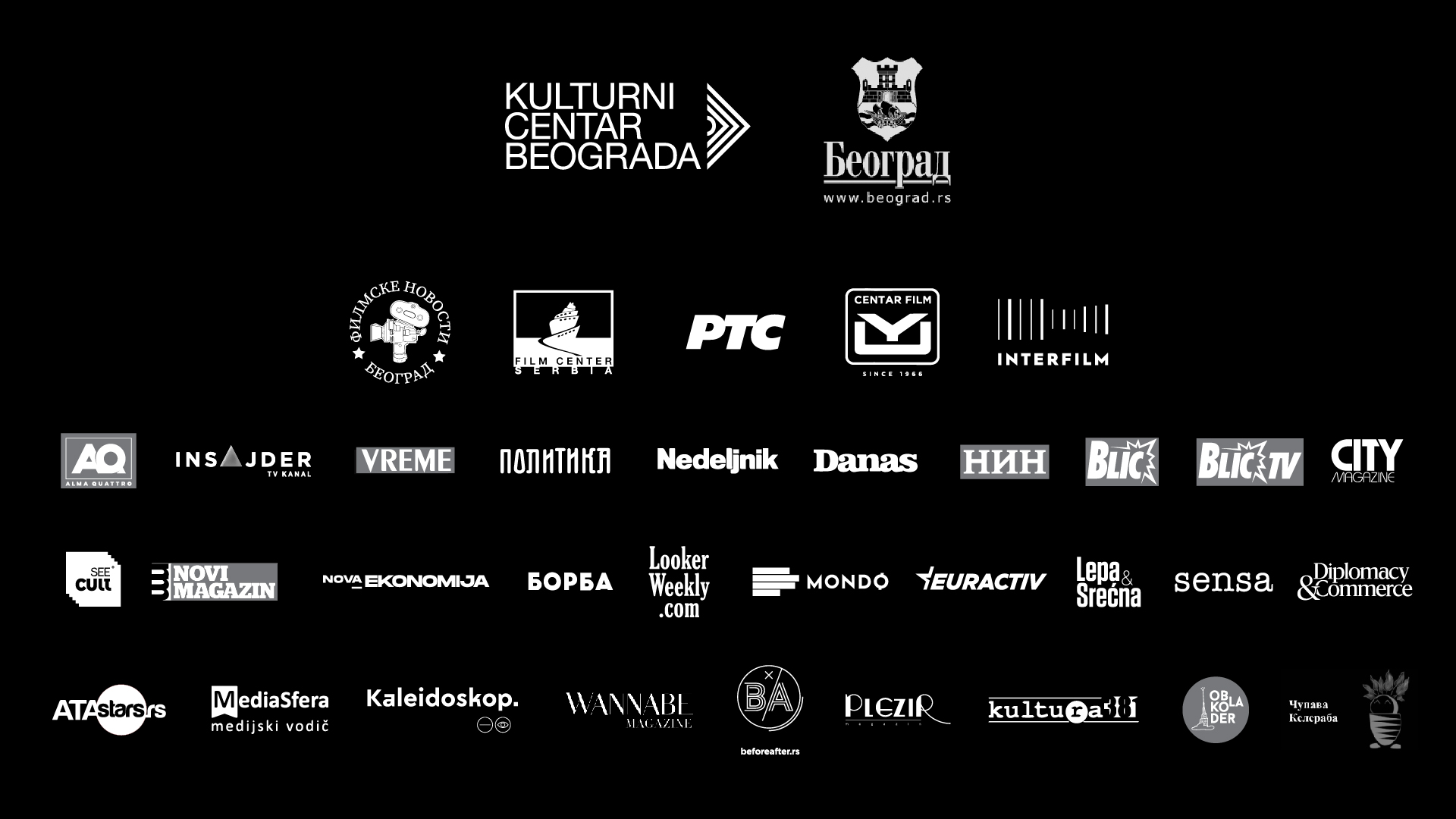DKC – 60 YEARS OF THE ICONIC BELGRADE CINEMA

DKC – 60 YEARS OF THE ICONIC BELGRADE CINEMA
Cultural Centre of Belgrade Movie Theatre, Kolarčeva 6
19–22 October, 2023
To mark the 60th anniversary of uninterrupted work of the of the Cultural Centre of Belgrade Movie Theatre, a series of very special programmes will be organised during October 19–22. Before looking into the future, we will reflect on the deep impact that this cinema has had on the cinematic and cultural life of Belgrade and Serbia.
The Movie Theatre of the Cultural Centre of Belgrade (DKC) is famous not only as the cinema for quality artistic film, but as the favourite retreat of cinephiles and film authors. Besides numerous Serbian and Yugoslav filmmakers of all generations, Hollywood star Burt Lancaster, French diva Sophie Marceau, the famous Polish-French filmmaker Andrzej Żuławski, the controversial Argentine director Gaspar Noé, Warhol’s associate and the iconic American avant-garde author Paul Morrissey, are just some of the famous names whose conversations with the Belgrade audience are still vividly remembered. Even David Lynch chose DKC as the venue for his exclusive, first public appearance after the conclusion of the third season of the Twin Peaks series in September 2017. In a direct video link on the cinema screen of DKC, while answering questions from our audience, Lynch mentioned considering continuing his work on Twin Peaks, which brought DKC into the spotlight of all the world’s media that reported this news.
DKC is home to almost all the most important festivals of our cultural scene, with some – such as the Auteur Film Festival and Free Zone – originating precisely in this cinema. At the same time, it regularly hosts film workshops and screenings of student and high-school films, supporting the very first steps of future important filmmakers.
Whether filmmakers are in attendance or not, this much is certain: DKC attracts a unique audience of refined, interesting and educated people, who have long been missing from our public life. DKC is their oasis. If you’ve come to DKC, it means you seek something more than Hollywood’s cinematic confections, equipped with a curious mind and a desire for a different sort of film – the one that doesn’t come with easy fixes – or films from oftentimes entirely unknown cinematographies. DKC does not boast a red carpet, or VIPs. Instead of external glamour, DKC is a place of cultural, intellectual and spiritual adventure.
The Cultural Centre of Belgrade Movie Theatre is the oldest active cinema in Belgrade. It was opened on 19 October, 1963 with a screening of Nikola Majdak’s animated short film “The Soloist” and Stole Janković’s feature film “Radopolje”. The cinema’s building, which is listed as a cultural monument of Serbia, was designed by Ratomir Bogojević, who envisioned DKC as one of the first duplex cinemas, although the second auditorium was never completed.
Marija Marinčić Majdak, its first and longest serving film editor, can be credited with multiple innovations in promoting the cinema arts. The public interest has been tremendous from the outset. She conceived the popular film program Non-stop cinema, which ran as a daily marathon of feature films, short films, documentaries, animated films, and newsreels. An annual review of the most-watched and best films, chosen with film critic Milutin Čolić of Politika newspaper, can be considered a precursor to FEST (largest film festival in then Yugoslavia).
She also established the very popular film programs The Film Critic’s Choice and Your Choice, inspired by a call to the public to select its three favourites out of a list of 800 films. These programs had proven that the judgement of the most eminent film critics and the public largely coincided at the time.
At the same time, the “mobile team” of DKC frequently went to schools, gymnasiums, or libraries in nearby or distant places with a 16mm projector, film reels and a screen, organising film screenings.
During the 1970s and early 1980s, every tenth citizen of Belgrade visited DKC at least once a year. The following years were marked by the great global crisis of cinema, caused by the proliferation of TV and home video, as well as copyright infringement. DKC managed to survive the wartime 1990s, international sanctions, the 1999 bombing campaign…
The contemporary concept of DKC in the 21st century was established by the distinguished film critic Nebojša Popović, who, with the support of the chief programme editor Vesna Danilović, has created the cinema’s film programme for years under the slogan “CINEMA OF GOOD FILM”, primarily focusing on high professional standards in artistic and auteur films. With his erudition and unstoppable dynamism, Popović launched and opened DKC to a series of events dedicated to specific European cinematographies, such as the Spanish meter and the Goethe Fest, or expertly tailored revues of national cinematographies such as Finnic, Austrian, Israeli, Romanian, Iranian documentary, and Japanese-Serbian film… The most significant film festivals in Serbia, FEST and BELDOCS, are regularly held at the cinema, which cooperates closely and successfully with younger authors, especially within the International Student Film Camp Interaction.
Around this time, the cinema joined the preeminent European cinema network, Europa Cinemas (2006), and became one of the first digitised cinemas in the country (2012), while still retaining the ability to screen films from 35mm reels.
After Popović’s untimely death in 2015, the Cultural Centre of Belgrade, in cooperation with nine other film founders, decided to honour him by creating the annual “Nebojša Popović Award” for the promotion and critique of film and culture. Film director Stefan Arsenijević took over the position of film editor in 2015, periodically bringing on board guest-editors, such as Bojan Vuletić, Melina Pota Koljević, and Maja Uzelac. The current editor of the film programme is Ivan Aranđelović.
The Film Gallery was opened in 2016 in the movie theatre’s monumental foyer, crowned by a magnificent dome, with the Grlom u jagode – 40 Years of Srđan Karanović’s TV Series exhibition. During this extraordinary event, all ten episodes of this cult series were shown on this cinema screen for the first time, followed by a discussion between the creators, the cast and the audience.
Exhibitions dedicated to important cineastes created for the Film Gallery are often invited for presentations elsewhere in the country and the region after their premiere in DKC. One of the most important exhibitions in the Film Gallery was Milena (2017), dedicated to Milena Dravić. The cinema hosted a discussion with Milena as part of the opening ceremony. The hall was too small to accommodate all the admirers of our greatest national film diva, who emotionally and candidly answered questions about her prolific film career for two full hours. It was also the last conversation of Milena Dravić (1940–2018) with the Belgrade audience.
From its inception to the present day, the Cultural Centre of Belgrade Movie Theatre has been an indispensable, iconic spot for each and every cinephile. It was often the place where cinematic history was made, a place of countless precious festivals, manifestations, meetings and discussions. New authors and film poetics were discovered. New worlds of cinema came into being. DKC is one of the key coordinates of this fine, authentic spirit of Belgrade, matched only by its loyal audience that makes it special and irreplaceable. Throughout six tumultuous decades, this movie theatre was and still is an oasis of art, culture, dialogue and meaning. We hope that stays true for another 60 years. As one of DKC’s old mottos used to say: It’s better in the cinema!
The programme can be found here: https://www.kcb.org.rs/en-us/2023/10/60dkc-programme/
Stories about the cinema by famous directors, journalists, film theorists and DKC associates (in Serbian): https://www.kcb.org.rs/2023/10/60dkc-price-iz-bioskopa/
IT’S BETTER IN THE CINEMA!
DKC / WHEN, WHERE, WHY…?
The building of the Press House in Belgrade was erected between 1958 and 1961 according to the project of one of the most eminent architects of that time, Ratomir Rata Bogojević. It gained the status of a cultural monument in 2019.
The design of the building was conceived as a centre for the cultural and informational life of the city. Due to a lack of funds and a change in investors, the project underwent alterations during its construction, leading to the abandonment of the initial concept of a comprehensive cultural and informational centre. The ground floor and the first floor were occupied by the Cultural Centre of Belgrade, while the second and third floors housed the Association of Journalists. The other floors were converted into commercial spaces. This sequence of events also led to a modification of the initial innovative project of a non-stop cinema with two theatres, one above the other. Originally, there was a plan for one entrance to the cinema from Kolarčeva Street and another from Knez Mihailova Street. However, as the second theatre was never built, the entrance area from Knez Mihailova was transformed into a gallery, and now houses the Art Gallery of the Cultural Centre of Belgrade. The DKC cinema was opened on 19 October, 1963.
The author of the Press House project, architect Rata Bogojević, also created the interior design of the cinema, which stands as an exceptional representative of the architecture and aesthetics of that era. The entrance, adorned with fine stone, the impressive staircase, and the domed foyer create a solemn atmosphere that introduces and prepares the audience for entry into the cinema hall. The cinema hall is excellently designed, with a well-constructed seating incline and perfect acoustics. The foyer space offers ample opportunities for exhibitions, musical performances, and panel discussions.
In line with the general concept of “flowing spaces” as one of the fundamental characteristics of the architectural project of the Press House, the Cultural Centre Movie Theatre is programmatically and spatially connected to other parts of the Cultural Centre of Belgrade. Spaces and programs flow, with activities transitioning from the cinema to the Podroom Gallery, from there into the bookstore, merging into the Art Gallery, Beogradski Izlog, and ascending to the Artget Gallery. But that is another story, one you will discover and read on your own.
Welcome to the Cultural Centre of Belgrade Movie Theatre, because IT’S BETTER IN THE CINEMA!
 Created and organised by:
Created and organised by:
Stefan Arsenijević, Vesna Danilović
Zorana Đaković Minniti, Ivan Aranđelović, Danica Jovović Prodanović, Bojana Aleksijević, Jasmina Petković
Visual identity:
Nenad Radojčić/Braća burazeri
Public relations: Mirjana Boba Stojadinović
Social media: Anđelka Tomašević
Special thanks:
Rajko Grlić, Srđan Karanović, Goran Marković, Đorđe Kadijević, Zdravko Šotra, Boro Drašković, Miša Radivojević, Želimir Žilnik, Lordan Zafranović, Slobodan Šijan, Emir Kusturica, Darko Bajić
To all authors of cinema stories
Radio Television of Serbia, Filmske novosti and Goran Tomčić
Boris Miljković, Goranka Matić
Nenad Radijčić, Zdenka Milanović